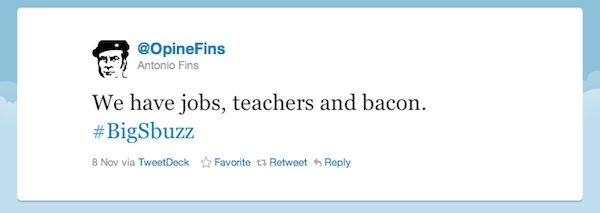
The editorial board can be one of the most opaque parts of a newspaper. That’s infuriating for many readers, considering the editorial team’s role as the tradition-bound conscience of the paper, not to mention bouncer for all letters to the editor. What constitutes transparency for many boards is a regularly scheduled public chit-chat in the community room of the local library: It’s coffee, shortbread, the liberal guy who rages on income inequality, and the conservative guy who always agrees with Cal Thomas.
The thing is, unlike the straight-news reporters down the hall, the editorial department can take all those fun/catty/just-short-of-libelous debates writers have with each other at their desks out into the open — because they’re allowed to have a opinion in public.
Actually, that’s sort of what happened at the South Florida Sun-Sentinel. Almost a month ago, the editorial writers and columnists for the Sun-Sentinel took their morning meeting onto Twitter, where they could pitch and pick apart ideas for the next day’s editorials, columns, and questions to readers. Beginning around 10 every morning, the discussion gets going around #bigsbuzz, starting with the topics of the day, like a casino bill making its way through the Florida legislature or the latest or the newest development out of the Herman Cain campaign. Antonio Fins, opinions editor for the Sun-Sentinel, said the loose, light-hearted nature of the meetings translates well into Twitter, which provides the added benefit of drawing in new readers. There’s a strangely robust, if truncated at times, conversation that takes place even within a 140 character limit. Writers have to condense their thoughts down to that limit, but over the course of the 45- to 60-minute conversation can still say plenty. It just falls on Fins to make sure the conversation keeps moving and the agenda for the next day’s page is set, he said.
As an example, here’s a selection of tweets from this morning’s meeting, where they discussed the firing of Penn State football coach Joe Paterno under a cloud of scandal. Was it worth doing something for tomorrow’s paper, and if so, what form should it take? You’ll get a good idea of the back-and-forth and the sprawling, informal tone, which does a pretty good job of evoking a newsroom bull session.
The Twitter meetings are the latest turn in a strategy started three years ago to move the editorial group in a digital direction. The original idea called for a kind of chat room where the staff could cast out editorial ideas feedback and refinement from readers. That gave way to online video of the editorial meetings, but the complication there was in the time necessary for the editing. (Fins said they may revisit video with a livestream using webcams in their offices.) Fins said the idea of taking the editorial team from behind closed doors was always popular — finding the best medium was the hard part. “For us, it’s a bit of a valve to let loose, have fun, and engage with people,” he said. Twitter was the right fit — or at least right for now — because it was a simple solution: The ability to talk with each other and bring in an audience. Fins said he alone picks up 5-10 followers a day because of the meetings. “It’s the one place where we as an editorial board members can be edgy, not as staid or deliberative,” Fins said.
Its also a device for promotion not just for the paper, but the individual writers. Because of the nature of opinion writing — just like sports columnists or journalism punditry — you’re known as much for your voice as who you’re writing for. “What I’m trying to cultivate here and make more transparent is our own individual viewpoints and personalities,” Fins said.
Fins has been at the Sun-Sentinel for 15 years, nine of those in the editorial department with the last five as editor. A lot’s changed during that time. And while they’re called on to do more work now (Fins reads most of the letters to the editor himself), that overextension hasn’t been for the worse. Fins tells me they’re now doing more community outreach than ever before. Aside from the online discussion they’ve kept a regular schedule of local forums where readers can discuss issues in the news and have face time with policymakers. They’re holding events that attract 200, sometimes 400 people.
“We’re not diminishing the role of the editorial board, we’re bringing more audience to it,” he said. The role of the institutional voice remains, Fins said, but perhaps more importantly, the role of institutional convener seems to have been expanded.